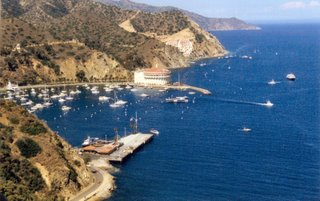 What this photo I took shows is actually the bay at Avalon (the only real city on the island). I don't usually like to use manmade things as part of my photos, but I did find this one particularly interesting. This island is south of the Northern Channel Islands (Santa Cruz, Santa Rosa, San Miguel).
What this photo I took shows is actually the bay at Avalon (the only real city on the island). I don't usually like to use manmade things as part of my photos, but I did find this one particularly interesting. This island is south of the Northern Channel Islands (Santa Cruz, Santa Rosa, San Miguel).On a clear day, Catalina can be seen from many of the California coastal towns like Laguna Beach, Newport Beach, Huntington Beach, Seal Beach, Hermosa Beach and Redondo. In its early history, this semi-arid Island offered limited plant resources, so the Islanders traded sea products and, in later years, steatite for their other needs. The Islanders made the 20-mile voyage to the mainland (and to the other Channel Islands) in well-crafted plank canoes.
Steatite (an easily carvable rock that does not crack when put in the fire) from Santa Catalina has been found in both mainland and Island sites throughout Southern California. The material culture of these hunter-gatherer peoples would have varied with the environment throughout the basin, but the maritime adaptations on the Islands and the immediate coast had much in common.
At the time of first European contact, it is thought that the people living on Santa Catalina Island called their island Pimu and themselves Pimungans (or Pimuvit). They were excellent seamen and paddled their plank canoes skillfully across the sometimes treacherous channel to trade. After Spanish colonization, their apparently flourishing population declined drastically with the introduction of new diseases to which they had little immunity. As the mission system altered the economic landscape of Southern California, the Pimungans' trade and social networks were disrupted. In the aftermath of this enormous culture shock, their society could no longer sustain itself. By the mid-1820s, the few Pimungans left had migrated or were moved to the mainland.
The Pimungans, along with other Native American groups that were in the sphere of influence of Mission San Gabriel, came to be referred to in the European community as Gabrielinos. There are people living in the Southern California area today who have Gabrielinos among their ancestors. Some are actively involved in researching and preserving their traditional culture.











